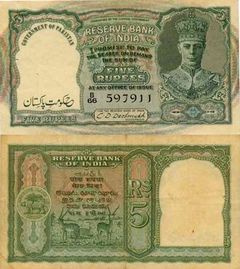عملة قانونية
عملة قانونية (إنگليزية: Legal tender أو forced tender).[1][2][3] وهي عبارة عن أوراق نقدية صادرة بحكم القانون، وتعتبر عملة قانونية حسب المقادير المبينة فيها بدون تحديد للكمية، وبمعنى آخر، إن القانون اعتبر المعاملات الجارية بين الأفراد غير محدودة بالكميات والفئات التي يختارونها من النقود الورقية طالما اكتسبت هذه الاوراق الصفة القانونية بالإصدار.
أما بالنسبة للمسكوكات النقدية فإن القانون يحدد عادة قوة الابراء على الافراد فقط، (مثال ذلك: ان يحدد القانون تسديد مبلغ كبير عشرة دنانير بفئات صغيرة من المسكوكات مثل الفلس كأن تكون فئة خمسين فلسا لا أقل من ذلك بالفلس مثلا)، أما خزائن الدولة فعليها أن تقبل المسكوكات المعدنية على اختلاف أنواعها دون تحديد لمقدارها.
أما النقود القانونية Lawful money. فيمكن تعريفها كالآتي:
- أي نقود سواء كانت على هيئة مسكوكات أو عملة ورقية يتم التداول بها بموجب القانون كواسطة لتبادل القيم.
- تعتبر الاحتياطات المصرفية Bank reseves المقبولة لأغراض معينة نقودا قانونية هي الأخرى.[4]
أصل النقود الورقية
كانت العملة في الولايات المتحدة في الماضي في صورة العملة الذهبية والفضية، ثم تطور الأمر إلى اصدار العملة الورقية المدعومة بالذهب. ثم أصبحت النقود ورقية ونقوداً معدنية، وهي نقود قانونية وليس لأحد حق رفضها. وقد مرت البلاد الأخرى بهذا التطور.
الوضع حسب البلد
الهند
The Indian rupee is the de facto legal tender currency in India. The Indian rupee is also legal tender in Nepal and Bhutan, but the Nepalese rupee and Bhutanese ngultrum are not legal tender in India. Both the Nepalese rupee and Bhutanese ngultrum are pegged with the Indian rupee.[5]
The Indian rupee used to be an official currency of other countries, including the Straits Settlements (now Singapore and parts of Malaysia), Kuwait, Bahrain, Qatar, and the Trucial States (now the UAE).
In 1837, the Indian rupee was made the sole official currency of the Straits Settlements, as it was administered as a part of India. In 1845, the British replaced the Indian rupee with the Straits dollar after administration of the Straits Settlements separated from India earlier in that same year.
After partition of India and Pakistan in 1947, the Pakistani rupee came into existence, initially using Indian coins and Indian currency notes simply overstamped with the word "Pakistan". New coins and banknotes were issued in 1948.
The Gulf rupee, also known as the Persian Gulf rupee (XPGR), was introduced by the Government of India as a replacement for the Indian rupee for circulation exclusively outside the country with the Reserve Bank of India Amendment Act of 1 May 1959. This creation of a separate currency was an attempt to reduce the strain put on India's foreign reserves by gold smuggling.
Two states, Kuwait and Bahrain eventually replaced the Gulf rupee with their own currencies (the Kuwaiti dinar and the Bahraini dinar) after gaining independence from Britain in 1961 and 1965, respectively.
On 6 June 1966, India devalued the rupee. To avoid following this devaluation, several of the states using the rupee adopted their own currencies. Qatar and most of the Trucial States adopted the Qatar and Dubai riyal, whilst Abu Dhabi adopted the Bahraini dinar. Only Oman continued to use the Gulf rupee until 1970, with the government backing the currency at its old peg to the pound. Oman later replaced the Gulf rupee with its own rial in 1970.
On 8 November 2016, Prime Minister Narendra Modi announced that existing INR 500 and INR 1000 banknotes would no longer be accepted as legal tender with a view to curb counterfeiting, tax evasion and the parallel economy.[6] The Reserve Bank of India outlined a scheme for holders of such banknotes to either deposit them into their bank accounts for full, unlimited value, or to exchange the banknotes for new, subject to a cap.[7]
انظر أيضاً
- عملة
- عملة رئيسية
- معدل الفائدة الإسمية
- معدل الفائدة الفعلية
- مردود الاستثمار
- الحد الأدنى للعائد
- مركز مربح
- مركز تكلفة
- مركز استثماري
- نظارة الحسابات
- تخصيص الأموال
- حجم الأعمال (اقتصاد)
- Gresham's law
- Postage stamp demonetization
- Standard of deferred payment
- حق سك العملة Seigniorage
المراجع
- ^ "معلومات عن عملة قانونية على موقع catalog.archives.gov". catalog.archives.gov.
- ^ "معلومات عن عملة قانونية على موقع d-nb.info". d-nb.info.
- ^ "معلومات عن عملة قانونية على موقع thes.bncf.firenze.sbn.it". thes.bncf.firenze.sbn.it.
- ^ كتاب القاموس الاقتصادي - تأليف حسن النجفي - مطبعة الإدارة المحلية - بغداد 1977 - صفحة 181 وصفحة 184.
- ^ "Area handbook Series/ Bhutan (Nepal and Bhutan) / Glossary". Country-data.com. Archived from the original on 9 سبتمبر 2009. Retrieved 3 مايو 2010.
{{cite web}}: Unknown parameter|deadurl=ignored (|url-status=suggested) (help) - ^ Trivedi, Sudhanshu (6 يونيو 2017). "The reputation of India as a soft state is over". The Indian Express. Archived from the original on 23 يونيو 2017.
{{cite web}}: Unknown parameter|deadurl=ignored (|url-status=suggested) (help) - ^ "Archived copy" (PDF). Archived from the original (PDF) on 9 نوفمبر 2016. Retrieved 9 نوفمبر 2016.
{{cite web}}: Unknown parameter|deadurl=ignored (|url-status=suggested) (help)CS1 maint: archived copy as title (link)
